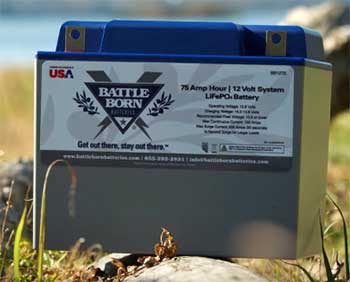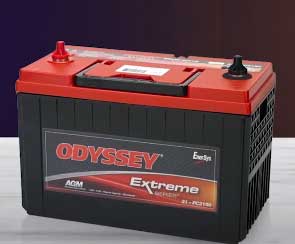If you’ve ever researched or shopped for batteries, you’ve probably heard about Group 24 and Group 31 deep cycle batteries. Both are widely recognized for their reliability and performance, but how do they stack up against each other?
Let’s delve deep into the world of batteries, comparing the key features, pros, and cons of Group 24 and Group 31.
A Brief Comparison Table
| Features | Group 24 Battery | Group 31 Battery |
| Standard Size (LxWxH) | 10.25″ x 6.8125″ x 8.875″ | 13″ x 6.8125″ x 9.4375″ |
| Weight | 40-50 lbs | 60-70 lbs |
| Capacity (20-hour rate) | 70-85 Ah | 95-125 Ah |
| Lifespan | 3-5 years | 4-6 years |
| Cost | Typically less expensive | Typically more expensive |
The Heart of the Battery: Understanding Deep Cycle
Before we dive into the Group 24 vs. Group 31 discussion, let’s shed light on what deep cycle means. In essence, deep cycle batteries are designed to provide a steady amount of power over a long period.
They can be deeply discharged using most of their capacity, hence the name “deep cycle.”
- Group 24 Deep Cycle Batteries: An Overview

Group 24 batteries are the smaller of the two and are commonly used in applications that require moderate power, such as marine, RV, solar, and backup power applications.
They’re designed to offer long-lasting power, and their compact size makes them a versatile option.
One of the main advantages of Group 24 batteries is their compact size, allowing for easy installation in spaces with size limitations.
They’re also typically more affordable than their larger counterparts, making them an excellent choice for budget-conscious consumers.
However, the capacity and lifespan of Group 24 batteries are comparatively lower than Group 31. This implies that they may not be the best option for power-intensive applications or situations that demand long-term power supply.
- Group 31 Deep Cycle Batteries: Powerhouse Performers
In contrast, Group 31 batteries are renowned for their robust power delivery and large capacity. These batteries are commonly used in heavy-duty applications like trucking, industrial machinery, and large-scale solar installations.
The substantial capacity of Group 31 batteries means they can deliver a steady flow of power for longer periods. Moreover, they have a more extended lifespan, which translates into less frequent replacement.
The downside? Their larger size can pose installation challenges, especially in constrained spaces. They’re also pricier than Group 24 batteries, meaning they might not be the best option for cost-sensitive scenarios.
Key Differences Between Group 24 and Group 31 Deep Cycle Batteries
Understanding the differences between Group 24 and Group 31 batteries is crucial to select the appropriate power solution for your specific needs. This section will delve into the critical differences in size, capacity, weight, lifespan, and cost.
- Size and Weight
One of the most apparent differences between the two types of batteries lies in their physical dimensions and weight.

Group 24 batteries are smaller with standard dimensions typically around 10.25″ (L) x 6.8125″ (W) x 8.875″ (H).
This smaller size allows for more manageable handling and easier installation, especially in spaces where room is a constraint.
The weight usually falls in the range of 40-50 lbs, making them lighter to handle.
In contrast, Group 31 batteries are larger, with standard dimensions approximately 13″ (L) x 6.8125″ (W) x 9.4375″ (H).
This bigger size often equates to a larger power capacity but may also mean additional challenges when it comes to installation, particularly in tight spaces. They are also heavier, typically weighing between 60-70 lbs.
- Capacity and Lifespan
Battery capacity is a crucial factor to consider as it dictates the battery’s ability to supply power over a given period.
Group 24 batteries usually have a capacity in the range of 70-85 Ah (Ampere-hours) when rated at a 20-hour rate. While this is ample for many applications, they may not be the best choice for devices or systems that consume a lot of power.
Their typical lifespan can be around 3-5 years with proper care and maintenance, but this can be shorter in more demanding applications.
On the other hand, Group 31 batteries usually have a higher capacity, typically between 95-125 Ah, again rated at a 20-hour rate. This makes them well-suited to power-intensive applications or situations that require a longer battery life.
With proper maintenance, these batteries can last for around 4-6 years, but the exact lifespan will depend on usage and care.
- Cost
The final crucial difference lies in cost. Because of their larger size, higher capacity, and extended lifespan, Group 31 batteries are generally more expensive than Group 24 batteries.
It’s essential to weigh this increased cost against the added benefits to determine which battery offers the best value for your specific needs.
Both batteries have their strengths and weaknesses, and the choice ultimately comes down to the specific needs of your application. If size and budget are crucial factors, Group 24 could be your best bet.
On the other hand, if capacity and longevity are more important, you might want to lean towards Group 31.
Also Read: Is Battle Born Better Than RELiON Battery?
Frequently Asked Questions (FAQ)
The primary difference lies in their size, capacity, and price. Group 24 batteries are smaller, have lower capacity, and are typically less expensive. Group 31 batteries, however, are larger, offer higher capacity, and come with a higher price tag.
Group 31 batteries are often used in heavy-duty applications such as trucking, industrial machinery, and large-scale solar installations where large power capacity and longevity are required.
Whether a Group 31 battery is “better” than a Group 27 battery depends on the specific application. Group 31 batteries are larger and have a higher capacity than Group 27 batteries, making them a better choice for power-intensive applications. However, they are also more expensive and require more space for installation.
Group 27 batteries are slightly larger and typically have a higher capacity than Group 24 batteries, making them suitable for applications that need more power. However, Group 24 batteries may be a better choice for spaces with size constraints or for users with a tighter budget.
Wrapping Up
In conclusion, both Group 24 and Group 31 deep cycle batteries have their unique attributes that make them ideal for different applications. Your choice between the two will largely depend on your specific needs and constraints.
Always consider the power requirements, available space, and budget before making a decision.
Happy battery hunting!

